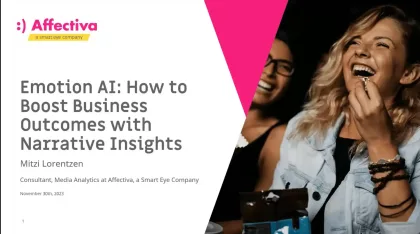In an increasingly digital and information-saturated environment where consumers’ attention is not limitless, understanding attention is fundamental for advertising success, now more than ever.
The marketing industry agrees on this pivotal role of attention, with 66% of marketers worldwide saying attention has an important influence on creative effectiveness (Media Reactions 2023).
For a long time, the common practice for advertisers and marketers has been using simple behavioral metrics such as the time viewed (playback) to define the attention their ad can command. While these measures are still prevalent, is getting views enough?
How can great attention measures elevate ads from playback to payback?
The role of attention in creative effectiveness requires to understand more than just viewability. To optimize your ads to command attention, it is also crucial to understand the depth of the attention beyond just catching the eye and measure the emotional engagement: active attention.
Join us in this webinar as we go deeper into the meaning of attention for advertising success, how to measure it and how to optimize your ads to capture attention. Experts from Affectiva and Kantar explore findings from their databases, Emotion AI analysis and share case studies to illustrate best practices.
Speakers

Graham Page
Global Managing Director of Media Analytics, iMotions

Ecem Erdem
Global Creative Thought Leadership Manager at Kantar

Duncan Southgate
Senior Director, Creative & Media Solutions at Kantar
🔑 Key Takeaways
📊 The State of the Industry
- Attention is gaining momentum as a key advertising metric.
- Industry leaders from Coca-Cola to the Advertising Research Foundation emphasize the need for better understanding and validation of attention solutions.
- A recent global survey of marketers showed widespread agreement: attention impacts both media and creative effectiveness, with a stronger influence seen on creative performance.
🧠 What Drives Attention?
- Ads must fight through today’s fragmented media environment. Passive viewability is no longer enough.
- Factors such as branding, storytelling, surprise, and emotion are critical for sustaining attention.
- Neuroscientific and biometric tools like eye-tracking and facial coding are being used to map what captures attention and how it translates to brand impact.
🔍 Attention Measurement in Practice
- Showing how attention metrics can be linked directly to ROI.
- They highlight multiple techniques, including:
- Facial coding and emotion recognition
- Eye-tracking across digital platforms
- Attention scores used to benchmark creative assets
📈 Case Studies & Practical Examples
- A series of case studies from FMCG and tech brands show how optimizing for attention lifted brand recall and purchase intent.
- Ads that aligned emotionally and delivered early branding cues were significantly more effective in commanding attention.
- High-performing ads were often those that felt personalized, emotionally resonant, and visually dynamic.
🧰 Strategic Recommendations
- Early Testing: Use attention insights during creative development, not just post-campaign.
- Right Context: Tailor creative for specific environments (TV, mobile, social) to better capture attention.
- Benchmark Creatively: Use cross-industry attention benchmarks to position your ad competitively.
🧭 Closing Thought:
“Don’t just chase views—command attention.” This webinar reframes how marketers should think about creative success, suggesting that integrating biometric and behavioral insights can unlock higher impact and ROI.




